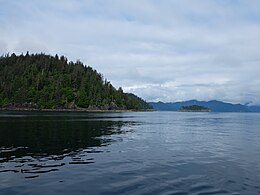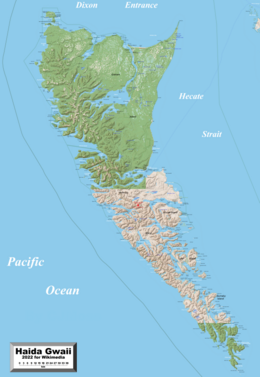Nickname: "Queen Charlottes" "The Charlottes" | |
|---|---|
 | |
 Map of Haida Gwaii | |
| Geography | |
| Location | Pacific Ocean |
| Coordinates | 53°N 132°W / 53°N 132°W |
| Total islands | c. 150 |
| Major islands | Graham Island, Moresby Island |
| Area | 10,180 km2 (3,930 sq mi) |
| Highest elevation | 1,164 m (3819 ft) |
| Highest point | Mount Moresby |
Canada | |
| Province | British Columbia |
| Largest settlement | Village of Daajing Giids (pop. 964) |
| Demographics | |
| Population | 4,526[1] (2021) |
| Pop. density | 0.445/km2 (1.153/sq mi) |
| Additional information | |
| Time zone | |
Haida Gwaii (/ˈhaɪdə ˈɡwaɪ/;[2] Haida: X̱aaydag̱a Gwaay.yaay / X̱aayda gwaay, literally "Islands of the Haida people"),[3] also known as the Queen Charlotte Islands, is an archipelago located between 55–125 km (34–78 mi) off the northern Pacific coast in the Canadian province of British Columbia. The islands are separated from the mainland to the east by the shallow Hecate Strait.[4] Queen Charlotte Sound lies to the south, with Vancouver Island beyond. To the north, the disputed Dixon Entrance separates Haida Gwaii from the Alexander Archipelago in the U.S. state of Alaska.
Haida Gwaii consists of two main islands: Graham Island (Kiis Gwaay) in the north and Moresby Island (T'aawxii X̱aaydaɢ̱a Gwaay.yaay linaɢ̱waay, literally: south people island half, or Gwaay Haanas "Islands of Beauty") in the south, along with approximately 400 smaller islands[4][better source needed] with a total landmass of 10,180 km2 (3,931 sq mi). Other major islands include Anthony Island (Ḵ'waagaaw / Sɢ̱ang Gwaay), Burnaby Island (Sɢ̱aay Kun Gwaay.yaay), Langara Island (Kiis Gwaay), Lyell Island, Louise Island, Alder Island (Ḵ'uuna Gwaay / Ḵ'uuna Gwaay.yaay),[3] and Kunghit Island.
On June 3, 2010, the Haida Gwaii Reconciliation Act formally renamed the archipelago to Haida Gwaii as part of the Kunst'aa guu – Kunst'aayah Reconciliation Protocol[5] between British Columbia and the Haida people.[2][6][7] The previous official name Queen Charlotte Islands was given by British explorer George Dixon in 1787 and the islands are known colloquially as "the Charlottes".[8]
The islands form the heartland of the Haida Nation, upon which people have lived for 13,000 years,[9] and who currently make up approximately half of the population.[10] The Council of the Haida Nation (CHN, X̱aaydaG̱a Waadlux̱an Naay) was established in 1974 to "strive for full independence, sovereignty and self-sufficiency of the Haida Nation".[11] As recently as 2015, the Haida Nation hosted First Nations delegations such as the potlatch and subsequent treaty signing between the Haida and Heiltsuk Nation.[12] A small number of Kaigani Haida also live on the traditionally Tlingit Prince of Wales Island in Alaska. In a deal negotiated between the government and the Haida nation over the preceding decades, British Columbia in 2024 transferred the title over more than 200 islands off Canada's west coast to the Haida people, recognizing the nation's aboriginal land title throughout Haida Gwaii.[13][14]
Some of the islands are protected under federal legislation as the Gwaii Haanas National Park Reserve and Haida Heritage Site, which includes the southernmost part of Moresby Island and several adjoining islands and islets. Coastal temperate rain forest at the shore, the preserve also includes the San Cristoval Mountains, so named by the first European explorer, Juan José Pérez Hernández, and the oldest surviving European place name on the BC coast. Facilities are minimal, and access is via boat or seaplane.[15] Also protected, but under provincial jurisdiction, are several provincial parks, the largest of which is Naikoon Provincial Park on northeastern Graham Island. The islands are home to an abundance of wildlife, including a large subspecies of black bear (Ursus americanus carlottae), and the smallest subspecies of ermine, the Haida ermine (Mustela haidarum haidarum), both endemic to the islands. Black-tailed deer, elk, beaver, muskrat, two species of rats, and raccoon are introduced species of mammals that have become abundant, imparting many ecological changes to the ecosystem.
- ^ "BC Population Estimates & Projections". bcstats.shinyapps.io. Retrieved 6 December 2022.
- ^ a b "Haida Gwaii". BC Geographical Names.
- ^ a b "Ship X̱aayda Kil Glossary" (PDF). sd50.bc.ca. Skidegate Haida Immersion Program. March 2011. Archived from the original (PDF) on 10 June 2012. Retrieved 19 February 2018.
- ^ a b "Welcome to Haida Gwaii: "Haida Gwaii is not only where we are, this is who we are"". Haida Gwaii Observer. 2018. p. 3. Archived from the original on 2019-06-04. Retrieved 2019-06-04.
- ^ Haida Nation; Her Majesty the Queen in Her Right of the Province of British Columbia (Autumn 2015). "Amending Agreement of the Kunst'aa guu - Kunst'aayah Reconciliation Protocol" (PDF). coastalfirstnations.ca. Archived (PDF) from the original on 21 February 2018. Retrieved 19 February 2018.
- ^ Legislative Assembly of British Columbia. "Bill 18 — 2010: Haida Gwaii Reconciliation Act". Queen's Printer. Archived from the original on 3 April 2012. Retrieved 17 March 2011.
- ^ "HAIDA GWAII RECONCILIATION ACT". www.bclaws.ca. Archived from the original on 2017-07-31. Retrieved 2017-07-02.
- ^ "Queen Charlotte Islands". BC Geographical Names.
- ^ "History: Where we've come from (our history)". Masset BC. Village of Masset. Archived from the original on 20 February 2018. Retrieved 19 February 2018.
Haida Gwaii has been home to the Haida since time immemorial, and evidence of their habitation of the islands dates back 13,000 years.
- ^ "History of the Haida Nation". Council of the Haida Nation. Retrieved 2014-08-16.
Today, Haida people make up half of the 5000 people living on the islands
Archived 2016-05-14 at the Wayback Machine - ^ "Mandate - Council of the Haida Nation". Council of the Haida Nation. 2019. Archived from the original on 3 May 2019. Retrieved 18 May 2019.
The CHN shall strive for full independence, sovereignty and self-sufficiency of the Haida Nation.
- ^ Erwin, Ryan (30 June 2015). "Heiltsuk and Haida nations finalize peace treaty". Global News. Archived from the original on 20 February 2018. Retrieved 19 February 2018.
- ^ Cecco, Leyland (2024-04-15). "Canada hands 'long-overdue' title over more than 200 islands to Haida Nation". The Guardian. ISSN 0261-3077. Retrieved 2024-07-05.
- ^ Onishi, Norimitsu; Bracken, Amber (2024-07-04). "On Small Islands Off Canada's Coast, a Big Shift in Power". The New York Times. ISSN 0362-4331. Retrieved 2024-07-05.
- ^ "Gwaii Haanas". Haida Gwaii. Haida Gwaii Observer. 2018. p. 22.
